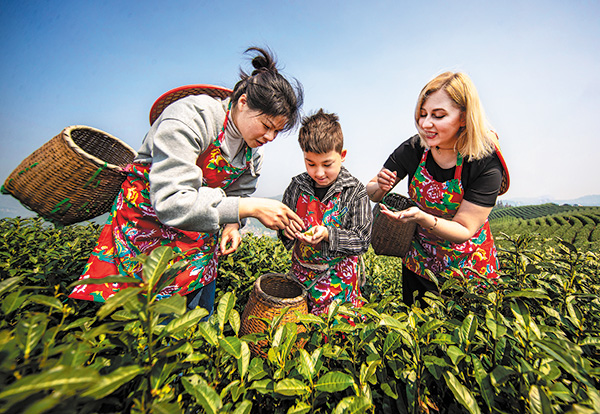Infused with history

Tourists experience tea picking in Shuanglian village, Hangzhou, Zhejiang province, in April.[Photo by Gu Zhaoming/For China Daily]
Signature drinks vary from country to country. When it comes to beer, naturally, we think of Belgium or Germany; whiskey, there's a good case for both Scotland and Ireland; coffee, a bit complicated, but Ethiopia, Brazil and Columbia, among others, immediately spring to mind. However, when we talk about tea, in terms of its birthplace, diversity, as well as production and consumption volume — there is only one answer: China.
Tea drinking has been an integral part of Chinese heritage and culture for centuries. For the Chinese, tea is not only adored as a pleasant beverage with a fragrant aroma, but also a necessity in Chinese people's daily lives, and is of profound significance to the economic and social development of the country.
Chinese tea has a long history, and it is a story of gradual refinement. The original idea is credited to the legendary Shennong, who, as far back as 2000 BC, discovered tea accidentally and found it could detoxicate the herbs and plants he was tasting, beginning a tradition that continues until today.
As a recreational drink, tea became popular during the Tang Dynasty (618-907). From it, a tea culture was established and spread throughout China, particularly after the completion of The Classic of Tea — an encyclopedia by Lu Yu, in the 8th Century, which compiled and recorded all the information about tea in different places of China, its origin, techniques for making the beverage and the correct way to drink it. Later, he earned the moniker "Sage of Tea".
Chinese tea culture flourished in the Song Dynasty (960-1279), during which the act of whisking tea became popular. The tea was first ground into fine powder, then hot water was added and tea was whisked in a bowl with a brush to create a foam, similar to how warm milk is treated to make a Cappuccino today. This method of preparing tea was later introduced to Japan and became the basis of Japanese matcha.
In China, during the Yuan and Ming dynasties (1271-1644), tea-making techniques continued to evolve, and that's when steeping became the primary way of preparing tea. During the Qing Dynasty (1644-1911), the use of loose-leaf tea became the norm that continues to today.

A high-speed train passes through tea plantations in China.[Photo by Liu Hao/For China Daily]
Chinese tea culture is very rich in both physical and spiritual terms. Physically, it consists of tea cultivation, brewing, serving techniques, methods of consumption and the tea ceremony. Spiritually, it contains the wisdom of oriental philosophy, reflecting the doctrines of Taoism, Confucianism and Buddhism.
As the core of the tea culture, the Chinese tea ceremony, which is also referred to as "tea art", focuses on achieving harmony through the tea, water, utensils, preparation, environment, atmosphere, music, infusion techniques and interpersonal relationships. Each cup of tea is brewed with ritual, and in the process of self-improvement for ancient Chinese literati and modern enthusiasts, etiquette is learned, inner peace is pursued, aesthetic and moral values are cultivated, and friendships are revived.
Tea has an obvious significance in improving personal health. Regular tea drinking can activate a detoxification process and help strengthen the body. Physical health is the prerequisite for pleasure and nourishment, and only through self-enjoyment can one sublimate the realm of life, and, thus, in return improve its quality. As the saying goes: One must see the world in a tea leaf; and heaven in a cup of tea. That's why, as a living heritage, Chinese tea enjoys huge popularity among all social strata, from ancient emperors and literati, to modern grassroots Chinese.
Chinese tea culture highlights tranquility within oneself and harmony with the others. Tea also serves as a bridge connecting China and the world.
It was the Dutch who first introduced Chinese tea to Europe, marking the start of tea drinking on the continent. The massive import of Chinese tea to Europe began in the 17th century. From 1720, the demand for tea, in Britain particularly, grew so rapidly that tea drinking became popular among people at all levels of society, making Britain the largest importer during the maritime tea trade in the 18th century.
The Tea Horse Road, which was part of a centuries-old trade network linking China with Southeast Asia and India, as well as the Maritime Silk Road, which was the maritime section of the historic Silk Road that connected China, the Arabian Peninsula and Europe, have both contributed to the Chinese tea trade and global cultural exchanges.
Related articles
-
 Luzhou promotes its spring tea in Beijing
Luzhou promotes its spring tea in BeijingMore
-
 The world's favorite beverage
The world's favorite beverageMore
-
 Fu tea gets a new lease of life in Shaanxi
Fu tea gets a new lease of life in ShaanxiMore
-
 Coffee farm volunteer programs enable young people to explore rural areas
Coffee farm volunteer programs enable young people to explore rural areasMore
-
 A Learning Journey: Episode 2 One Cup of Turkish Coffee
A Learning Journey: Episode 2 One Cup of Turkish CoffeeMore
-
 Tea synonymous with Changsha, especially for younger people
Tea synonymous with Changsha, especially for younger peopleMore
